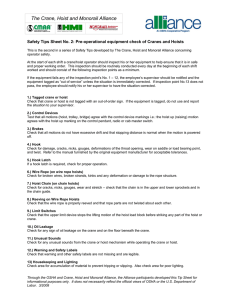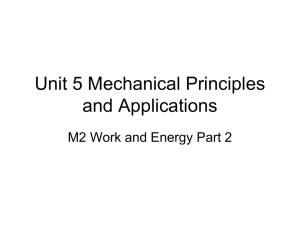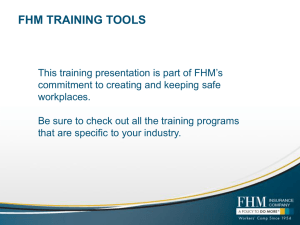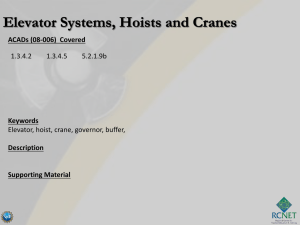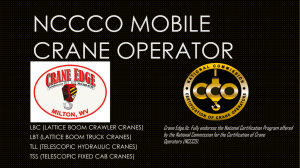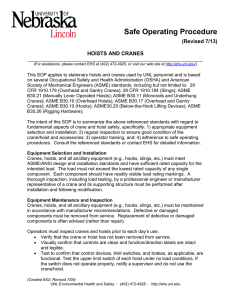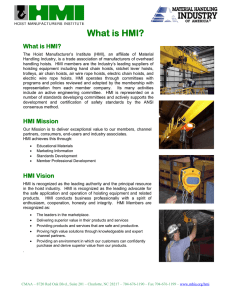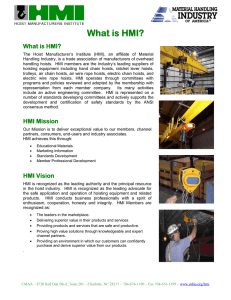Operating Policy and Procedure November 2, 2012
advertisement
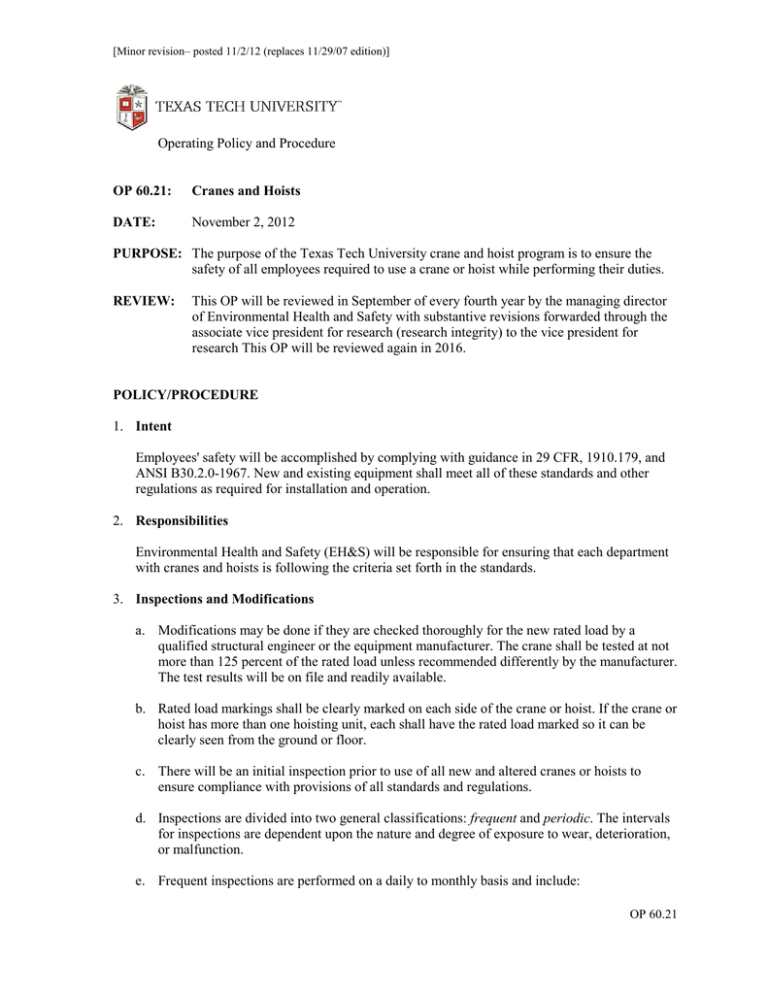
[Minor revision– posted 11/2/12 (replaces 11/29/07 edition)] Operating Policy and Procedure OP 60.21: Cranes and Hoists DATE: November 2, 2012 PURPOSE: The purpose of the Texas Tech University crane and hoist program is to ensure the safety of all employees required to use a crane or hoist while performing their duties. REVIEW: This OP will be reviewed in September of every fourth year by the managing director of Environmental Health and Safety with substantive revisions forwarded through the associate vice president for research (research integrity) to the vice president for research This OP will be reviewed again in 2016. POLICY/PROCEDURE 1. Intent Employees' safety will be accomplished by complying with guidance in 29 CFR, 1910.179, and ANSI B30.2.0-1967. New and existing equipment shall meet all of these standards and other regulations as required for installation and operation. 2. Responsibilities Environmental Health and Safety (EH&S) will be responsible for ensuring that each department with cranes and hoists is following the criteria set forth in the standards. 3. Inspections and Modifications a. Modifications may be done if they are checked thoroughly for the new rated load by a qualified structural engineer or the equipment manufacturer. The crane shall be tested at not more than 125 percent of the rated load unless recommended differently by the manufacturer. The test results will be on file and readily available. b. Rated load markings shall be clearly marked on each side of the crane or hoist. If the crane or hoist has more than one hoisting unit, each shall have the rated load marked so it can be clearly seen from the ground or floor. c. There will be an initial inspection prior to use of all new and altered cranes or hoists to ensure compliance with provisions of all standards and regulations. d. Inspections are divided into two general classifications: frequent and periodic. The intervals for inspections are dependent upon the nature and degree of exposure to wear, deterioration, or malfunction. e. Frequent inspections are performed on a daily to monthly basis and include: OP 60.21 November 2, 2012 f. Page 2 (1) All functional operational mechanisms for maladjustment- performed daily; (2) Deterioration or leakage in lines, tanks, valves, drain pumps, and other parts of air or hydraulic systems- checked daily; (3) Hooks with deformation or cracks, or with safety latches missing- visual inspection daily; monthly inspection with a certification record, which includes the date of inspection, name, and signature of inspector and serial number or other identifier of the hook inspected. If the hook is cracked or has more than 15 percent excess throat opening or more than 10 percent twist, the hook shall be replaced; (4) Hoist chains will follow the same guidelines as the hook inspection above; and (5) Crane or hoist ropes will be inspected for reeving according to manufacturer recommendations Periodic inspections are performed at 1- to 12-month intervals. Complete inspections shall be performed on the crane or hoist on a schedule of 1 to 12 months, depending upon its activity, severity of service, and environment. They will be inspected for: (1) Deformed, cracked, or corroded members; (2) Loose bolts or rivets; (3) Cracked or worn sheaves and drums; (4) Worn, cracked, or distorted parts such as pins, bearings, shafts, gears, rollers, and locking and clamping devices; (5) Excessive brake wear; (6) Excessive wear of chain drive sprockets and excessive chain stretch; and (7) Electrical apparatus for deterioration, limit switches, and push button stations g. A crane or hoist that has been idle for more than one month but less than six months shall be inspected using the frequent inspection checklist, and h the inspector's name, the date of inspection, and identification of the crane or hoist inspected will be documented. h. A crane or hoist that has been idle for more than six months shall be given a complete inspection conforming to frequent and periodic inspections, to include the inspector's name and the date of inspection. This documentation must be kept on file and readily available. i. Standby cranes or hoists shall be inspected at least semi-annually to conform to frequent inspections. OP 60.21 November 2, 2012 Page 3 4. Testing a. Prior to use, all new or altered cranes or hoists shall be tested to ensure compliance by checking the following functions: (1) Hoisting and lowering; (2) Trolley travel; (3) Bridge travel; and (4) Limit switches Locking and safety devices are to be checked with an empty hook and by increasing speeds up to the maximum. The actuating components shall be set to trip the switch under all conditions in sufficient time to prevent the hook from hitting the trolley. b. All cranes and hoists will be tested as per these guidelines. The operators of all electric cranes and hoists will follow these guidelines. The operators of all manual cranes and hoists will follow the guidelines for frequent inspections given above. 5. Maintenance Preventive maintenance shall be based on the crane or hoist manufacturer's recommendations. Prior to maintenance, the following shall be done: a. Locate the crane or hoist so it does not interfere with operations in the area; b. Place all controllers in the off position; c. Lock out the main power supply; d. Tag-out the crane or hoist to inform other employees that maintenance is being performed on the equipment; and e. After maintenance, all guards shall be replaced, safety devices reactivated, and tools removed before checking operation of the equipment. 6. Rope Inspection Inspection of the wire rope shall be performed monthly and a record kept with date of inspection, name and signature of inspector, and identification of the ropes inspected. This information shall be kept on file and readily accessible. The following items shall be checked or observed: a. Reduction of rope diameter; b. Corrosion of internal or external wires; c. Number of broken outside wires and the degree of distribution and concentration on the rope; d. Worn or corroded wires at the end connectors; OP 60.21 November 2, 2012 Page 4 e. Corroded, cracked, or improperly attached connections; and f. Severe kinking Any rope that has been idle for a month or more will receive a full inspection with the date of inspection, name and signature of inspector, and identification of the rope. This will be documented and remain on file and readily available. 7. Handling Loads The following procedures will apply while handling a load: a. The crane, hoist chain, or rope will not be wrapped around the load. b. The load should be attached using a sling or other approved device. c. The load shall be balanced in the sling or lifting device before lifting it more than a couple of inches. d. The crane or hoist rope shall not be kinked. e. The crane or hoist should not be used for side pulls. f. No load should be hoisted while employees are on the load. g. Loads should not be carried over individuals. h. The brake shall be tested each time a load is moved at the rated capacity of crane or hoist. i. A load should not be lowered below the point where there are less than two full wraps of rope left on the drum. j. The operator shall not leave her/his position at the controls while the load is suspended. 8. Crane and Hoist Limit Switches The following procedure will be followed while checking limit switches: a. At the beginning of the operations shift, the empty hook shall be raised slowly to ensure that the upper limit switch is operational. If not, a repair shall be made before using the equipment. b. The upper limit switch shall never be used as an operational control. 9. Ladders and Stairways a. Ladders and stairways shall be securely fastened and comply with 29 CFR, 1910.27. b. Stairways will be equipped with handrails and stair surfaces will be anti-slip material. OP 60.21 November 2, 2012 Page 5 10. Holding Brakes a. Holding brakes shall be applied automatically when power is disconnected. b. Holding brakes shall have an adjustment means. c. All brake drums shall be maintained with a smooth surface. d. Brakes may be applied by mechanical, electrical, pneumatic, gravity, or hydraulic means. 11. Electric Equipment a. All wiring shall adhere to the National Electric Code. b. The control circuit shall not exceed 600 volts. c. The pendant control voltage shall not exceed 150 volts AC and 300 volts DC. d. The pendant shall be supported by some means to prevent strain on the electric wire. e. The pendant control buttons shall be clearly marked as to their function. f. Lockout and tagout procedures will be used while maintenance is being done. OP 60.21
